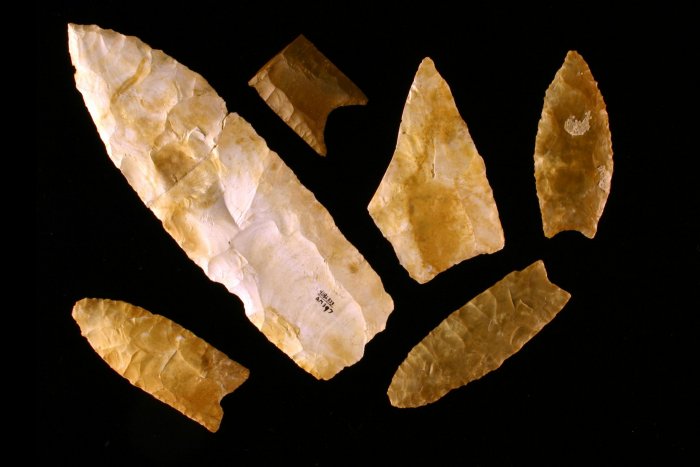Conny Waters – AncientPages.com – Tools made by some of North America’s earliest inhabitants were made only during a 300-year period, according to a new study.
The findings may help solve the mystery surrounding the origin and demise of these people.
 Clovis spear points from the Gault site in Texas. Center for the Study of the First Americans, Texas A&M
Clovis spear points from the Gault site in Texas. Center for the Study of the First Americans, Texas A&M
The Clovis – a prehistoric culture named for stone tools found near Clovis, New Mexico in the early 1930s – once occupied North America at the end of the last Ice Age.
New testing of bones and artifacts show that Clovis tools were made only during a brief, 300-year period from 13,050 to 12,750 years ago.
The team used the radiocarbon method to date bone, charcoal and carbonized plant remains from 10 known Clovis sites in South Dakota, Colorado, Pennsylvania, Ohio, Virginia, Montana and two sites in Oklahoma and Wyoming. An analysis of the dates showed that people made and used the iconic Clovis spear-point and other distinctive tools for only 300 years.
“We still do not know how or why Clovis technology emerged and why it disappeared so quickly,” Michael Waters, distinguished professor of anthropology and director of the Center for the Study of the First Americans said.
“It is intriguing to note that Clovis people first appears 300 years before the demise of the last of the megafauna that once roamed North America during a time of great climatic and environmental change. The disappearance of Clovis from the archaeological record at 12,750 years ago is coincident with the extinction of mammoth and mastodon, the last of the megafauna. Perhaps Clovis weaponry was developed to hunt the last of these large beasts.”
“Until recently, Clovis was thought to represent the initial group of indigenous people to enter the Americas and that people carrying Clovis weapons and tools spread quickly across the continent and then moved swiftly all the way to the southern tip of South America. However, a short age range for Clovis does not provide sufficient time for people to colonize both North and South America. Furthermore, strong archaeological evidence “amᴀssed over the last few decades shows that people were in the Americas thousands of years before Clovis, but Clovis still remains important because it is so distinctive and widespread across North America,” Waters said.
“Clovis with its distinctive fluted lanceolate spear point, typically found in the Plains and eastern United States, is contemporaneous with stemmed point-making people in the Western United States and the earliest spear points, called Fishtail points, in South America.
“Having an accurate age for Clovis shows that people using different toolkits were well settled into multiple areas of North and South America by 13,000 years ago and had developed their own adaptation to these various environments.”
Paper
Written by Conny Waters – AncientPages.com Staff Writer





